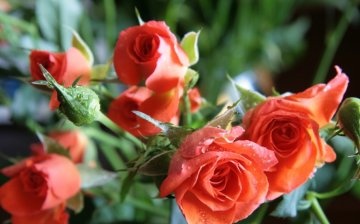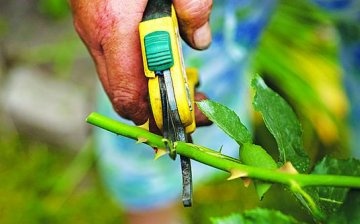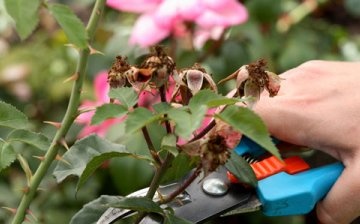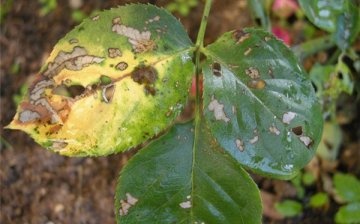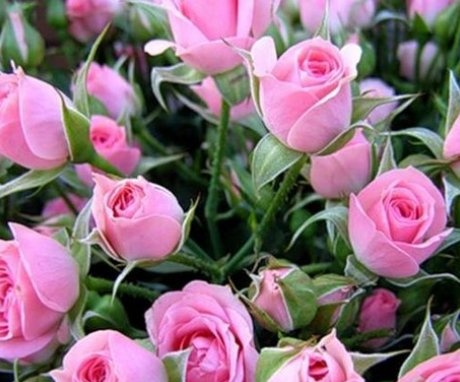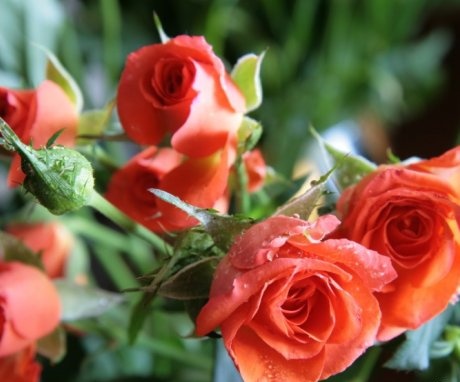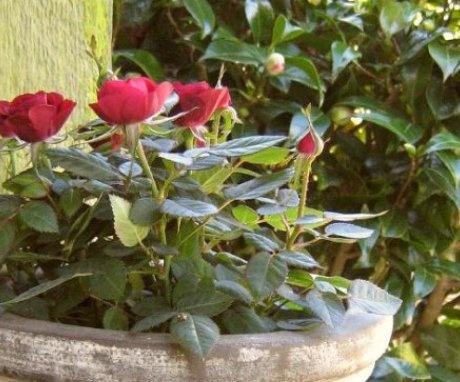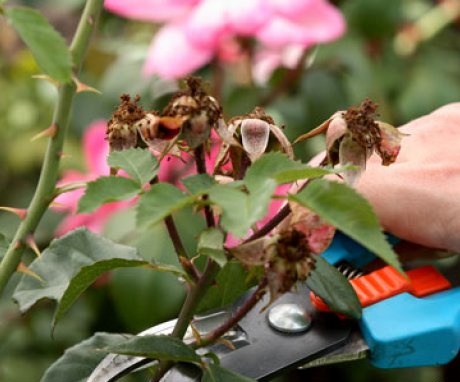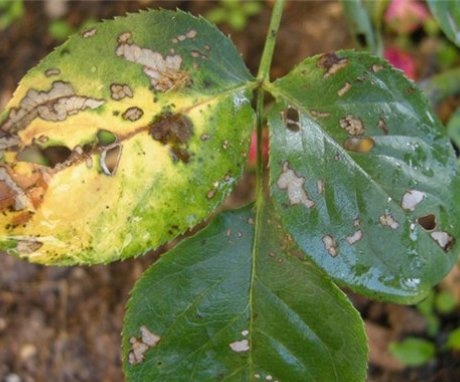Dwarf roses - an exquisite highlight of your garden
rose flower at all times it was considered the most beautiful decoration of the garden. Any variety and shape of a flower is equally beautiful and unique. Along with the usual varieties of roses, miniature varieties are distinguished. These kids are able to decorate curbs, flower beds and alpine slides. They, like the brush strokes of an artist, bring brightness and variety to the flower decoration of the garden.
Dwarf roses are easy to care for and grow. Many gardeners plant queen flower miniatures in hanging containers and flowerpots. Any garden will instantly transform and attract the attention of guests. This short gardener encyclopedia will tell you about the correct growing, care and reproduction of babies. Useful tips will help you grow bright and sophisticated miniature roses in your backyard.
Content:
- Features of dwarf roses
- The best species and varieties
- Growing conditions
- Care tips - watering and feeding
- Reproduction of dwarf roses
- Pruning and replanting
- Diseases and pests
Features of dwarf roses
Many believe that an unusually small bush roses came to us from China. But according to historical sources, the cultivation of this plant was started in Switzerland. It was there that they paid attention to the unusual size of the rose and decided to select it. Breeders from Holland, Germany and the USA later joined the Swiss specialists. So the little miracle spread throughout Europe and America. A large number of varieties and types of dwarf roses were bred, in no way inferior in beauty and aroma to an ordinary rose.
The main feature of miniature plants is their size.
It can be a small shrub from 12 to 35 cm in size or a rose with unusual flowering lashes reaching 1 m in length. Dwarf roses can grow not only in the garden, but also at home - this is the second feature of this unusual plant. Despite the seeming vulnerability of the fragile bush, the rose perfectly tolerates the harsh Russian winters. If the grower decides to grow the plant outdoors, it is preferable to choose frost-resistant species. There are a great many of them.
The dwarf rose, due to its size and lashes, is perfect for decoration curbs, verandas, attics and flower beds. Florists plant small bushes against the background of higher flowers - a very spectacular flower meadow is obtained. Landscape designers use dwarf roses to decorate stone embankments or alpine hills, where an ordinary rose would look out of place with its rather tall stems. The features of a dwarf rose allow you to roam the fantasies of a florist and decorate your favorite garden.
The best species and varieties
In order not to be mistaken in choosing a garden treasure, it is necessary to determine in advance how and where it will grow. Whether it will be a decoration for an apartment, balcony or garden. Whether you want to grow a little miracle and admire it all year round or only in the summer months.
The selection of a variety will depend on the following factors:
- Rose dormant period
- Growing a plant at home or outdoors
- Period flowering (all year round at home or summer months in the garden)
The dormant period implies the wintering of the plant or its absence.If the baby is growing at home, then you can choose a variety of year-round flowering without a dormant period. If you plan to grow a baby in the garden, then a frost-resistant variety with a dormant period in the winter months is needed.
Florists identify and advise the following types of dwarf roses:
- Variety "Kolibri" - bright yellow-orange flowers up to 5 cm in diameter, dense foliage, suitable for growing at home, on balconies and verandas in pots. Disease resistant.
- Variety "Sonnenkind" - flowers of a bright sunny color with a diameter of 3-4 cm, dense foliage, suitable both for home and for open ground. Winter hardy, not exposed diseases.
- Variety "Madi" - known for its bright scarlet flowers, the reverse side of the petals is whitish with a silvery bloom. Looks spectacular anywhere - at home, in the garden, on the balcony or on an alpine slide. Roses are visible from afar due to their very bright and unusual color. Reaches 40 cm in height. Winter-hardy variety, not afraid of diseases.
- Variety "Meirov" - bright red inflorescences with a juicy yellow stroke in the middle of the flower with a diameter of 3 to 5 cm. Reaches 40 cm in height. Suitable for outdoor and home growing. Winter hardy, not afraid of diseases. Florists love the variety for its unpretentiousness and brightness of colors.
- Sort "Rosemary" - pale pink, silvered. Dense and abundant greenery, suitable for both indoor and outdoor cultivation. Winter-hardy variety, not afraid of diseases and pests.
The list of species and varieties of dwarf roses is great. Florists advise, first of all, to determine the purpose and location of the future beauty of the garden and after that choose a variety. Many rely on the appearance and color of inflorescences. The main thing is that the plant looks healthy when you buy it.
Growing conditions
A spectacular plant, despite its general unpretentiousness, requires good lighting. When planting in open ground, it is better to choose a sunny area that is well ventilated. The dwarf rose does not like abundant moisture and dew. This condition always provokes the appearance of fungus and mites.
The best place for a baby rose will be a hill on the south side of the garden.
The plant must be planted so that the harsh north wind does not disturb it. On the north side, you can enclose roses with decorative plantings. Not recommended to grow roses in too shaded and damp places. The site must be ventilated.
Growing soil:
- In terms of soil, a dwarf rose thrives in regular garden soil. However, it is preferable to grow the plant in soils rich in clay and sand with little or no acidity.
- Dry, sandy soils are not suitable for dwarf roses. If there is only such soil, then it must be fertilized with humus and clay (2 buckets of clay x 2 buckets of humus x each m?).
- Damp soil is drained and enriched with sand and humus in the same proportions.
- Ordinary garden soil is treated with complex mineral fertilizers.
- Try to plant the rose in clay and well-ventilated areas, where the sun will illuminate the plant from morning to evening.
Landing in the ground is usually carried out in May, sometimes in April. The planting of a rose depends on its variety. Most types of dwarf roses are not afraid of frost. Therefore, they can be planted earlier. Many people plant roses directly in pots, if they do not plan to leave them in the ground for the winter. When fully planted without a pot, the plant is sunk in the soil shallowly - 3-4 cm. The distance between the bushes should be 20-30 cm, depending on the variety. It is recommended to cover the rose at first with a non-woven material. She must adapt to the sun and soil.
Care tips: watering and feeding
It is necessary to care for roses in any case, regardless of where they grow - in the open field or at home. For the entire growing season, the plant is recommended feed several times - 3-4.The first portion of the necessary substances should enter the soil immediately after the opening of roses - hibernation.
In the first half of the growing season, flower growers feed roses with nitrogen fertilizers, in the second - phosphorus-potassium.
When buds appear on the bush, fertilize with a complex mineral fertilizer. About two months before frost top dressing plants are stopped and given time for natural preparing for winter.
During the growing season, it is necessary to monitor soil moisture - the optimal frequency of watering is 2-3 times a week at an average summer temperature. It is advisable to loosen the soil and make sure that a crust does not form under the bush.
Preparing plants for winter comes down to covering them with coniferous spruce branches. A frame is erected over the bushes, which is covered with any insulation and film. It is not recommended to cover dwarf roses too early, they tolerate the first frosts well and without protection. Roses are opened in early spring and produced pruning.
Reproduction of dwarf roses
Miniature beauty breeds cuttings - the middle part of the shoots. If a rose grows outdoors, grafting best done at the end of May or during June.
Cutting procedure:
- It is recommended to choose shoots with three buds.
- The stem is cut at an acute angle under the bud from below and above it from above.
- The cuttings are immersed for several hours (8-10) in the Epin nutrient solution. The proportions of the solution - 100 g of the drug is diluted per 1 liter of water.
- After the cuttings are planted in prepared soil in a box.
- The first layer implies good drainage, consisting of sand, gravel or expanded clay.
- The usual garden land is laid out on it. It is advisable to sprinkle the soil with a layer of sand.
- Cuttings are often planted and covered with foil.
The plant in the first month should be in conditions of high humidity. In the second month, the box can be ventilated periodically. The rooted cutting begins to bloom profusely only in the second year. For the winter, cuttings are covered in the same way as an adult plant with the help of coniferous spruce branches and insulation with a film.
Pruning and replanting
Pruning roses must be done in the spring immediately after opening. Remove all dead shoots during hibernation. If necessary, the bush is thinned out. Shoots are cut at an angle above the bud.
It is recommended to leave three to four buds on the stem.
Transplant baby roses from a pot to the ground are made in the spring in April-May, depending on the variety. If a rose is planted out of the house into the open ground, you must first take it out into fresh air and leave it outside for some time to adapt. Only after that do they start disembarking. If you plan to plant a rose in the soil in a pot, they act according to the same scheme, but for the winter they dig up the rose and take it to the house. You cannot leave a rose in a pot for the winter, only in the open field.
Pruning and replanting a plant is not a big deal. Gardeners are advised to constantly prune faded inflorescences for their quick set of color again. From a bush, you can cut no more than 2-3 branches with roses for a bouquet or a gift.
Diseases and pests
The most common pests and diseases of the rose are aphids, spider mites, powdery mildew and rust. If the gardener did not see the appearance of ailments and parasites in time, the plant dries up and dies very quickly. With the timely identification of enemies, it is necessary to take action.
Pests and diseases can be removed using spraying plants with solutions. This will require copper sulfate (20 g), soap shavings (200 g) and water (10 L). The components are mixed in warm rainwater. Spraying is best done early in the morning or at dusk.
Another proven remedy is spraying a rose with a Bordeaux mixture.
To prevent the appearance of pests, the rose is planted next to lavender and garlic... They repel aphids and ticks.Good ventilation and regular loosening of the soil will prevent rose diseases.
Armed with the necessary knowledge, a florist will be able to grow a bright and incredibly beautiful flower bed dwarf roses. They will decorate not only a flower meadow, but also borders, hedges, verandas, alpine slides and house windowsills. Good luck growing your little miracle - a miniature rose!
More information can be found in the video.





